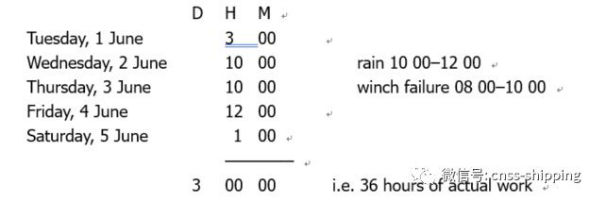Laytime Clauses 装卸时间条款
Calculation of weather interruptions in weather working days
良好天气工作日因天气中断的计算
2.59 The leading case on how these are to be calculated is Reardon Smith Line Ltd v. Ministry of Agriculture. However, before considering this, it may be useful to see how the law has developed.
2.59关于如何计算天气中断的著名判例,当属Reardon Smith Line Ltd v. Ministry of Agriculture 案。然而,在探讨这个案例之前,先看一下相关法律是怎样发展的,或许有益处。
2.60 The distinction between calendar and conventional days has already been considered. However, even where the laytime was calculated in calendar days so that laytime ran from midnight to midnight, after 1897 the courts were nevertheless prepared to count weather interruptions in terms of half days. This was the result of a decision of Lord Russell of Killowen CJ in Brankelow Steamship Co Ltd v. Lamport & Holt.
2.60在前面我们已经探讨了日历日和传统约定日之间的差别。然而,尽管是按照日历日来计算装卸时间,因此,装卸时间也是从午夜延续到午夜,在1897年以后法院仍然准备把因天气中断以半天为单位计算。这曾经是首席大法官 Russel of Killowen勋爵在Brankelow Steamship Co Ltd v. Lamport & Holt—案中的判决结果。
2.61 The Highfield, the vessel concerned in this case, was fixed to load at two ports, the first being Rosario. Cargo was to be loaded at a rate of 175 tons per weather working day, giving a total time available for loading of 16.7 weather working days, which was as usual rounded up to 17 days. At Rosario rain interrupted loading on at least one day, although on the particular day the weather cleared up in the afternoon and a considerable quantity of cargo was loaded. The shipowners wanted to claim the day as a whole day but the charterers argued that only a portion should count. Supporting charterers’ contentions, Lord Russell said:
Suppose the weather on a particular day is at first such that there is a reasonable expectation that a day’s work may be done, but after two or three hours’ work it changes so that it becomes unreasonable or impossible to work at all. Are the charterers then to be charged with that day as a whole day because they worked in good faith while the weather permitted? Such a thing would, to my mind, be inequitable:... There might be a succession of days upon which work was begun. If they were counted as whole days the charterer might not have the benefit of half the number of days actually allowed him under his charter. It would be inequitable to reject such days from the calculation altogether, because the ship gains something from despatch. A still more equitable view is this. Do not cut the days into fine fragments, but, if a half-day, or thereabouts, is used, calculate it as a half day; and if twelve hours are occupied calculate it as a whole day.
2.61在这个案子中所涉及到的船舶,‘Highfield’轮船,当时被确定在两个港口装货,其中第一个装货港是阿根廷的Rosario港。是以每个良好天气工作日175吨的速率装货,经计算可用于装货的全部时间为16. 7个良好天气工作日,按照通常的作法,对此经四舍五入得出17天。在Rosario至少有一天因为下雨而使装货作业中断,尽管在那一天的下午天气变晴了而且装了相当数量的货物。船东欲主张将那天算作一整天,但是承租人却坚持只应将其作为一天中的一部分加以计算。在支持承租人的观点的同时,Russell勋爵说: 假设在某一特定的一天里,起先的天气状况是完全有理由预计这一天的作业是可以进行的,但是在二/三个小时之后,天气发生了变化,变得根本不应该或不可能再进行作业了。那么就因为在天气允许时承租人善意诚实地从事了作业,难道就应该把那一天作为一整天来让他们负责吗?这种事,在我看来,是不公平的……或许会出现一连好几天作业都只是开了个头就不得不停止的情况。如果把这些天都作为整天来计算的话,承租人很可能连租船合同允许他实际使用的日数的一半都享用不到好处。拒绝将这类日子合起来一并计算也是不公平的,因为该船从速遣中获得了某种利益。一个更为公平合理的观点是这样的,即不必把这些日子过细地分成几个部分,但是,如果使用了半天或者半天左右的时间,就把它计为半天;而如果占用了 12个小时,则将其计为一整天。

2.62 In Alvion Steamship Corporation Panama v. Galban Lobo Trading Co SA of Havana (The Rubystone), Lord Goddard CJ objected to what he called this ‘‘rule of thumb’’ method of dealing with weather interruptions as being far too imprecise by limiting the fraction to be counted to half days. To this extent, the House of Lords in the Reardon Smith case agreed with Lord Goddard, although they disagreed with him on the method of calculation to be followed.
2.62 在Alvion Steamship Corporation Panama v. Galban LoboTrading S A of Havana(The Ruby stone)案,首席大法官Goddard勋爵反对这种把限定的部分时间计算为半天来处理天气中断的被他称之谓‘经验规则’的方法,因为这种方法太不精确了。在这一方面,上议院曾在Reardon Smith—案中赞同了Goddard勋爵的上述见解,虽然他们并不同意他所采用的计算方法。
2.63 Although now discredited, the method adopted by Lord Goddard is worthy of some consideration still, since it highlights the alternative meanings that could be given to the phrase ‘‘weather working days’’. Lord Goddard’s view is summed up in the following extract from his judgment:
. . . I think a working day is a length of time consisting of a number of hours which, according to the custom of the port, are usually worked at the port of discharge or loading, as the case may be, and the presence of the word ‘‘weather’’ seems to qualify it so that from the number of hours which would be the ordinary hours of the port is to be deducted the length of time during which the weather interferes with the work.
2.63尽管现在已不足为信,但是Goddard勋爵当初所采纳的方法如今仍然具有某种研究的价值,因为它强调了可以赋予‘良好天气工作日’这一用语的另一种不同的含义。Goddard勋爵的观点在下述他的判词的摘录中被作了概括。他说:
……我认为,工作日是一个时间长度,它由若干个小时段所组成。这些个小时段,根据港口的习惯,通常被用在该港的装货或卸货作业的时间,视具体情况而定,而‘天气’这个词的出现看来是要对这一点加以限定,因此,要从属于该港正常作业时间的小时数中扣除因天气干扰而影响工作的那段时间。

2.64 What was meant by the ‘‘ordinary hours of the port’’ was the question that arose in NV Maatschappij Zeevart v. Friesacher Soehne (The Leto) —did it include overtime? Elwes J held that it did not. The calculation should be based on the number of hours worked at standard rates.
2.64 ‘该港正常作业时间’是什么意思,这就是曾经在NV Maatschappij Zeevart v. Friesacher Soehne( The Leto)—案中所提出过的问题——它包括额外加班的时间吗? Elwes法官判定是它不包括加班时间。这种计算应该以标准费率支付作业的时数为基础。
2.65 In essence, therefore, under this method of calculation, working day means the working part of the day and the laytime statement is laid out showing for each calendar day the number of hours worked, up to a maximum of the ordinary hours of the port. The actual time of each stoppage is deducted, whether this is due to weather or some other excepted cause and the allowed laytime is used up when the total expended reaches a figure in hours arrived at by multiplying the ordinary hours of the port per day by the number of weather working days allowed.
2.65因此,根据这种计算方法,实质上工作日就是指那一天中用于作业的那部分时间,而所制定的装卸时间事实记录上显示的则是每个日历日实际作业的时数,直至该港正常作业的最长时数。每一次停工的实际时间都要被扣除,而无论这种停工是由于天气引起的还是由于其他某种除外的原因所造成。当全部花费的时间达到了以‘该港每天正常作业时数’乘以‘所允许使用的良好天气工作日的天数’所求得的以小时表示的数值时,所允许使用的装卸时间就被用完了。
2.66 In the following example showing such a calculation, three weather working days have been allowed as laytime; the ordinary hours of the port are 07 00–19 00; laytime commenced at 16 00 on 1 June, and there were two interruptions—one due to weather between 10 00–12 00 on 2 June and one due to a winch failure between 08 00–10 00 on 3 June.

《装卸时间与滞期费》购买链接(点击可购买)

公益出版译著《Aikens on bills of lading》第二版中英文对照,筹款链接(可点击进入)
海运圈聚焦专栏作者 魏长庚船长(微信号CaptWei)

 2018-04-14
2018-04-14 1831
1831 












